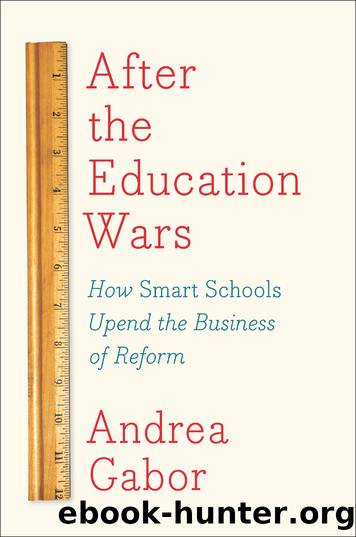After the Education Wars by Andrea Gabor

Author:Andrea Gabor
Language: eng
Format: epub
ISBN: 9781620972007
Publisher: The New Press
Published: 2018-05-10T00:00:00+00:00
GETTING KIDS TO TAKE OWNERSHIP OF THEIR LEARNING
In the past, I provided questions to my kids, and they had to research them. This year, I decided to let them come up with the questions; we’d model what is a good question. My kids just took off.
After the students had completed their research, the class looked back and reflected on what they had learned. I got the ball rolling by explaining how, in the old days, I used to give the questions, but thought this might be a better way.
To which one little boy responded: “What do you mean you used to give the questions? Isn’t that silly! How did you know what we wanted to learn?”
—Jasmin Razminsk, third-grade teacher, Parkside Elementary78
To start the process for a student-centered culture, Hejl enlisted her leadership team. Always inclined to be inclusive, she also encouraged others to join the team. “What I don’t like about team leaders or leadership teams,” says Hejl, as an aside, “is it identifies one person [as being] over seven others.”
Then, she stepped back and let the teachers take the lead. Using quality-improvement and consensus-building tools, the teachers brainstormed and came up with a concept they called the Parkside Scholar. A line drawing of an androgynous child—the “scholar dude,” as he came to be called—was gradually invested with a set of twelve scholarly characteristics. Using a consensogram, a survey that provides a snapshot of a group’s perceptions and understanding of a task, over two dozen teachers came up with twelve Parkside scholar traits. By far the most agreement—twenty-six teachers—was on “Parkside Scholars Make Connections,” followed by “Parkside Scholars Wonder and Question” and “Parkside Scholars Thrive in Learning Communities.”79
Beginning in 2010, Parkside focused on one of the twelve traits each month in classroom activities, on the school website, and in an assembly. The month focused on reflection brought a tsunami of mirrored objects to school. “We talked about the importance of reflection,” says Hejl. “That’s one of your highest learning tools either privately, written, or shared verbally. We tried to start building reflection into regular practice.”80
To drive home the idea of “making connections,” kids made link chains to show connections between ideas in the books they were reading and what they saw in the outside world.
When they focused on “giving back,” another of the scholarly traits, Hejl brought in stacks of heart-shaped Post-it notes for students to mark places in books where characters were giving back.
Kids also were encouraged to bring the traits to life. Thus, giving back might mean helping a classmate who spilled her juice or offering to help parents at home. Hejl says she began hearing from parents about kids who started offering to do the dishes. For the concept to be meaningful, says Hejl, the traits would “need to transfer to your everyday life.”81
Five years later, a child-sized model of the scholar dude made of wood and colorful beads and buttons greets you inside the door and remains an intimate part of life and the curriculum at Parkside.
Download
This site does not store any files on its server. We only index and link to content provided by other sites. Please contact the content providers to delete copyright contents if any and email us, we'll remove relevant links or contents immediately.
| Administration | Assessment |
| Educational Psychology | Experimental Methods |
| History | Language Experience Approach |
| Philosophy & Social Aspects | Reform & Policy |
| Research |
The Art of Coaching Workbook by Elena Aguilar(48044)
Trainspotting by Irvine Welsh(20046)
Twilight of the Idols With the Antichrist and Ecce Homo by Friedrich Nietzsche(17703)
Fangirl by Rainbow Rowell(7828)
Periodization Training for Sports by Tudor Bompa(7324)
Change Your Questions, Change Your Life by Marilee Adams(6637)
This Is How You Lose Her by Junot Diaz(5755)
Grit by Angela Duckworth(4729)
Red Sparrow by Jason Matthews(4655)
Asking the Right Questions: A Guide to Critical Thinking by M. Neil Browne & Stuart M. Keeley(4567)
Paper Towns by Green John(4165)
Room 212 by Kate Stewart(4099)
Ken Follett - World without end by Ken Follett(3968)
The Sports Rules Book by Human Kinetics(3582)
Housekeeping by Marilynne Robinson(3397)
The Motorcycle Diaries by Ernesto Che Guevara(3326)
Introduction to Kinesiology by Shirl J. Hoffman(3297)
Exercise Technique Manual for Resistance Training by National Strength & Conditioning Association(3288)
Double Down (Diary of a Wimpy Kid Book 11) by Jeff Kinney(3267)
